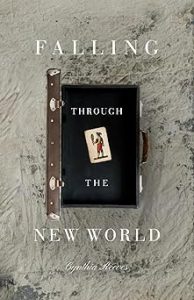Falling Through the New World: Honoring the Immigrant’s Story
Falling Through the New World
Honoring the Immigrant’s Story
by Cynthia Reeves
 My novel in stories Falling Through the New World (Gold Wake Press 2024) arose out of a fascination with my personal history as the American granddaughter of Italian immigrants and the events that spurred that history—World War I and the Spanish Flu epidemic of 1918. My mother often told the story of her own mother surviving the epidemic while her sister perished, calling for water to quench her thirst until her last breath.
My novel in stories Falling Through the New World (Gold Wake Press 2024) arose out of a fascination with my personal history as the American granddaughter of Italian immigrants and the events that spurred that history—World War I and the Spanish Flu epidemic of 1918. My mother often told the story of her own mother surviving the epidemic while her sister perished, calling for water to quench her thirst until her last breath.
That image of two sisters sharing very different fates traveled with me down the years until I could finally understand enough about Italian history and that country’s involvement in World War I to write about their impact on my characters’ lives, primarily through the lenses of the stories’ female protagonists.
Falling Through the New World follows four generations of an Italian-American family set against the often tumultuous events of the past century. From the collection’s inception twenty years ago, I envisioned it as a novel in stories rather than a traditional novel. My “plan” was to follow the Desiderio family from World War I Italy to present day America, delving deeply into certain aspects of Catholic faith and Italian culture as opposed to creating a sweeping arc found in such multi-generational family sagas as The Joy Luck Club and The Godfather.
While I admire writers of traditional novels, I have never been able to write one. Indeed, my approach to my longer works has always been fragmentary. Certain episodes, anecdotes or sketches become foundational and give rise to material that must fill in the gaps.
Part of the art of a novel in stories, as opposed to the traditional novel, is juxtaposition. The reader tackles each story in relation to the others, finding ways in which the stories interconnect. The linkages in Falling Through the New World involve how successive generations handle similar events (such as a mother’s death or the task of caretaking) or face new challenges that arise as the culture and external forces change—forces such as war, pandemics, the vicissitudes of the stock market, and the evolving dictates of the Catholic Church.
Aside from the image I carried for so many years of the “breakage” in my family lineage caused by my great-aunt’s death, and later the death of my first uncle, I was fortunate to have stories and artifacts to draw upon. Storytelling is part of the Italian-American culture, a fixture of the Sunday afternoon multi-course dinner whose preparation began in the early morning hours with the frying of meatballs and sausage in pure lard flavored with garlic and parsley—an odor that permeated the house. In my case, my mother and uncle together with extended family would trade stories about our ancestors both in English and Italian (when they didn’t want us to fully understand the context).
Likewise family history was passed down in artifacts—photographs, postcards, my grandmother’s bobbin lace and handmade linens, and recipes. Among these artifacts is a postcard of my grandfather at the Italian front near Isonzo in World War I. How my grandfather was able to have his photo taken near the front—let alone post this sweet missive to his “gentil signorina” back home—is still a mystery to me. Their village Vacri becomes Roccamaro in the stories, and of course, the stories themselves are fiction.
My rich family history was not enough, however, to write these stories. Research was integral to their creation. I must admit that I almost prefer research to the actual writing process—it’s much less terrifying than the blank page. I searched out the mustiest corners of libraries containing rare copies of soldiers’ diaries from World War I, read exhaustive histories of the war, the Spanish flu, the stock market crash, the Kennedy assassination, the significance of the Holy Face of Manoppello (thought to be the veil placed over Jesus’ face in the tomb), the tedious process of bobbin lace-making, and the caretaking of heart failure and stroke patients in the mid-twentieth century.
Combing through records on such sites as Ancestry.com was also essential. There, I found the immigration manifests for both of my grandparents’ voyages. To honor their memory, I used the actual ships—and in my grandmother’s case, the actual sailing dates—to ground the immigration stories “Providence (November 1922)” and “Black Tuesday.”
Finally, I couldn’t have written Falling without taking many trips back to my ancestral home. I was fortunate to have my mother along for several of these trips, including three we took to Vacri and Manoppello. I marveled at the way in which long-lost relatives whom we had never before met treated us like family. Some were even old enough to have known my grandparents. What a thrill to meet someone who could tell me how much I looked like their “Annina”!
Despite the rich sources of factual information I relied on for inspiration, the stories themselves are works of fiction. While I wanted to honor my family’s history, I also wished to take care not to betray family secrets. Beyond that, even stories handed down from generation to generation become muddled. How much is “true,” how much is embellished or distorted through the sequential transmission—as in a game of telephone tag—who knows?
Throughout the twenty years it took me to write this novel in stories, my goal was to honor the immigrant’s story more broadly than the “facts” embedded in my own family history.
—
FALLING THROUGH THE NEW WORLD
 There are so many ways to measure time, to wish ahead and to dream backwards. Here, with grace and deep, echoing wisdom, Cynthia Reeves yields the generations of an Italian family. Loss follows yearning. Love yields to regret. Distances are traversed, reversed, and finally emptied. The only seams in this lustrous novel-in-stories are those that come at the noble hands of an unforgettable tailor who dares to leave Italy behind to stake a bold claim in hope.
There are so many ways to measure time, to wish ahead and to dream backwards. Here, with grace and deep, echoing wisdom, Cynthia Reeves yields the generations of an Italian family. Loss follows yearning. Love yields to regret. Distances are traversed, reversed, and finally emptied. The only seams in this lustrous novel-in-stories are those that come at the noble hands of an unforgettable tailor who dares to leave Italy behind to stake a bold claim in hope.
-Beth Kephart, My Life in Paper: Adventures in Ephemera
Cynthia Reeves’ expertly crafted novel-in-stories finds artistry in manual labor and reveals the sacred in the everyday. Twists of lace ribbon, a tailor’s steady stitching, thread looped into intricate patterns to make a wedding or mourning veil, a string of rosary beads, notches in a wooden tabletop marking time and human presence: Reeves uses these heirlooms and artifacts to seamlessly bind generations of an Italian-American family, old country to new, past to present. Falling Through the New World is a deeply moving story of the Desiderio family-a history in handwork that is the truest expression of faith in the future.
BUY HERE
Cynthia Reeves is the author of three books of fiction: the novel in stories Falling Through the New World; the novella Badlands, awarded Miami University Press’s Novella Prize; and the novel The Last Whaler (Regal House Publishing). Her fiction, essays, and poetry have appeared widely and won numerous honors, including Columbia Journal’s 2010 Fiction Prize for “Falling Through the New World.” Reeves has earned residencies to the 2017 Arctic Circle Summer Solstice Expedition, Hawthornden Castle, Galleri Svalbard, and Vermont Studio Center. In August 2024, she will participate in the Arctic Circle Alumni Expedition scheduled to circumnavigate Svalbard. A graduate of Warren Wilson College’s MFA program, she has taught in Bryn Mawr College’s Creative Writing Program and Rosemont College’s MFA program. Learn more at cynthiareeveswriter.com.
Category: On Writing
























